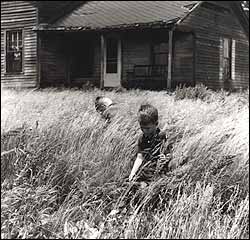
Ralph Eugene Meatyard was born in Normal, Illinois. Which sounds like the opening of a baroque American novel. Nobody in the real world has a name like Meatyard. And nobody called Meatyard grows up in Normal. Only a word-drunk fantasist would dream up such origins. But, in fact, Meatyard really was from Normal. And he lived up to the circumstances of his birth in an unexpected way. Instead of becoming an outlandish figure in a picaresque novel, he turned into a photographer who bewitched the American ordinary, an uncanny seer who offered heightened, almost Delphic glimpses into the hidden patterns of the world.
An exhibition of his work, “Ralph Eugene Meatyard,” at the International Center of Photography, is now creating an unexpected stir. Meatyard (1925–1972) is not well known outside the photography world; for many people he’s a discovery. Although he did exhibit during his lifetime, Meatyard was never a full-time professional working the strings and pulleys of reputation. Instead, he earned his living as an optometrist in Lexington, Kentucky—a resonant choice of occupation for a photographer—taking pictures on the weekends and printing in the darkroom at night. His friends, among them the Trappist monk Thomas Merton and the poet Guy Davenport, came mostly from the literary rather than the art world. (Davenport selected the images for the show, which was organized by Cynthia Young.) And Meatyard died young, before he could make a significant impact on the audience for art.
He’s appealing today partly because he seems unusually sincere, a virtue now regarded with nostalgia. Meatyard wasn’t hip, flashy, or detached. He made small black-and-white photographs that are damp with emotion: moody, melancholy, haunted. They might even seem sentimental if he weren’t also tough-minded and austere. He’s also appealing because he had a great subject—children. He first began taking photographs to document the lives of his children, as many fathers do, but soon became fascinated with the art of photography and quickly mastered its technical ins and outs. Early on, he made both abstract photographs and documentary images of an African-American section of Lexington. It was not long, however, before he began taking his family on weekend drives into the countryside, where he would stop at ruined or decayed mansions and farmhouses and ask his children to pose on that southern-gothic stage.
Meatyard understood children, appreciating, in particular, their charming ungainliness and poignant posturing. But he did not idealize them, romanticize their surroundings, or make trite observations about youth and decay. What becomes of them once they enter the lush ruins of the adult world? Meatyard’s best images, as Davenport suggests, resemble “short stories that have never been written.” They seem full of hints and whispers, like the murmurings of fate; each lapidary detail has symbolic import. At the edge of one image, a small boy stands in shadowy profile. Three richly detailed old doors hang ajar in front of him. The door closest to the boy is the plainest, the one in the center has a mysterious luminosity, the last seems to be the darkest. The doors could represent choices to be made, or, perhaps, foretell the evolution of his life. Or maybe they’re just beautiful rectangular forms. In Meatyard’s shadowy work, the future is never finally resolved, or not in a way that we can fully read.
Meatyard liked to make photographs that include two children, each of whom usually has a very different prospect. For example, he once isolated two brothers in an unstable sea of grass; both look down and away from an old settled farmhouse, but one is facing us and the other has turned his back. Sometimes he moved the camera in order to transform a person into a ghostly blur. He was also drawn to masks and the leering grotesque. But the images in this exhibit that include masks are, paradoxically, more ordinary and less magical than his other work, perhaps because the use of masks is a hoary and self-conscious Modernist device. The strongest Meatyards, apart from the photographs of children, are landscapes. They often have a romantic but also homespun quality, without any showy Ansel Adams bravura. In one series called “Motion-Sound,” Meatyard created landscapes that actually seem to tremble with meaning. He would just jiggle the camera a little, as if to spring the spirit from the form.

The photographs at ICP were selected by Ralph Meatyard’s longtime friend, poet-scholar Guy Davenport. The two met in 1963, after a friend wrote to Davenport about “a photographer who took pictures of children and American flags in attics.” Meatyard took many portraits of his friend; one appears on the cover of Davenport’s book Flowers and Leaves. For this show, Davenport chose 172 of the 400 “good Meatyards” he’d selected in 2001 from the several thousand prints owned by the photographer’s estate and the University of Kentucky Art Museum.
Ralph Eugene Meatyard
International Center of Photography.
Through February 27.